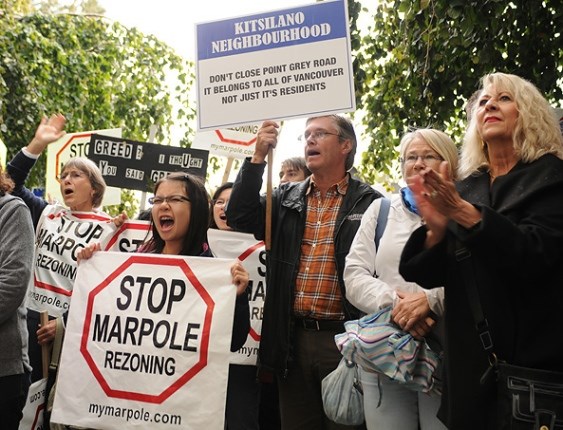Wednesday’s Vancouver council committee meeting to consider “Next Steps,” a staff report regarding four controversial community plans, began with a self-serving presentation by the city’s senior planner Brian Jackson and his two deputies outlining the extent of their public consultation in the Downtown Eastside, Grandview-Woodlands, the West End and Marpole neighbourhoods.
Jackson was aided in his preening presentation by softball questions from Mayor Gregor Robertson about the unprecedented “depth and breadth” of city staff’s engagement throughout this exercise. But it quickly became clear, once members of those communities were able to speak, that they held quite a different view; the process was an exercise in disappointment at best and betrayal, manipulation and deception at worst. (My deadline allowed me to only hear the first few.)
First to the microphone was Ray Spaxman, the iconic former Vancouver city planner who was originally recruited because of his work in Toronto by then mayor Art Phillips back in the ’70s to begin a dramatic new era in Vancouver city planning that was based on public engagement. He also established an atmosphere in the planning department where debate was robust.
Spaxman was speaking as the co-chair of the Downtown Eastside Local Area Planning Committee (LAP). It includes the many and varied often-difficult-to-deal-with stakeholders in the city’s poorest neighbourhoods.
He said through his 50 years of involvement in public consultations he’s learned “it is important not to deal with citizens as fools.” As part of the arrangement that gave Spaxman hope the process would work were the Terms of Reference signed off on in August of 2011 between LAP and city manager Penny Ballem.
Those terms included a written commitment from Ballem that before any neighbourhood draft plan for the Downtown Eastside was presented to council, LAP would not only receive a copy but would have time to consider the proposal and have their comments included as part of the staff presentation. Instead, he said, fewer than 24 hours before Wednesday’s meeting, staff dumped a 92-page package on the LAP committee which only represented half of staff’s report. Another package of equal size is yet to come.
Spaxman was puzzled as to why Ballem would allow this breach of her agreement. He said if staff continued on its current course of action “the important consultative process would be shortcircuited. Disagreements would be unresolved and council would be faced with acrimonious debate about unresolved differences.” He said LAP wanted more time predicting that “if you rush it you will end up with a failure.”
Next up was Jak King, president of the Grandview-Woodlands Area Council. He said the staff report to council “is an indictment of abject failure” in his neighbourhood. Recall that last June city staff produced a startling report recommending, among other things, towers of 30 or more storeys for the corner of Commercial and Broadway in spite of the fact, as King notes, in the 18 months of consultation “ not a single moment was given to the discussion of important land use and rezoning proposals.” The reaction in Grandview-Woodlands was explosive and derisive.
And on Wednesday, even Vision councillor and former Grandview-Woodlands resident Andrea Reimer had to admit she “experienced some surprise” at the staff proposals. As to how those proposals got into the plan, Jackson will only say they came from “the planning department.” That effectively throws his staffer, the neighbourhood’s respected young local area planner Andrew Pask, under the bus by implication, when planning department insiders say that it was Jackson himself who inserted those towers. Now, in the scramble to recover, the city will throw more money ($275,000) at Grandview-Woodlands and staff has proposed a reset on the process without, it should be noted, any consultation with the community. That will include, as King points out, “just vague promises of a Citizens’ Assembly — whatever that may be.”
There will also be some other changes to the most egregious proposals and time lines will be extended. But be sure of this: In the Ballem-Jackson universe we are seeing more than the usual mess involved in community planning. The notion of citizen engagement ushered in by Spaxman had become a bit of a sham. And that robust debate once encouraged in the planning department has been replaced by a culture of fear and blame.
agarr@vancourier.com



